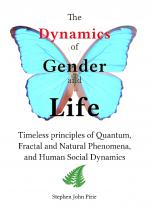People like us, who believe in physics, know that the distinction between past, present, and future is only a stubbornly persistent illusion.
A human being is a part of a whole, called by us the 'universe', a part limited in time and space. He experiences himself, his thoughts and feelings as something separated from the rest... a kind of optical delusion of his consciousness.1
Key Principle of Life, for Life No. 2a:
All times exist at-once
Pasts, presents and futures occur at-once
in the unlimited fullness of 'now.'
As the late physicist John Wheeler sought to reveal, "human consciousness shapes not only the present but the past as well."2
"Wheeler conjectures we are part of a universe that is a work in progress; we are tiny patches of the universe looking at itself— and building itself. It's not only the future that is still undetermined but the past as well. And by peering back into time, even all the way back to the Big Bang, our present observations select one out of many possible quantum histories for the universe."3
The universe is newly forming, at all times.
Our usual serial, sequential experience of time is a consequence of limited perceptions and focus. What may come to exist, or may have existed cannot be entirely disconnected from, or independent of our present circumstances.
Our moment-to-moment experience of time is supported by, and embedded in a deeper, nonlocal (at-once) interconnected 'ground' that everywhere and everywhen interconnects.
For some future or past event to be entirely disconnected from, independent of, or unrelated to our present circumstances would require an absolute separation that was not able to be bridged, engaged or journeyed – we would have no consequential or sequential experience of time and events, no individuality and no individual awareness.
- 1. Albert Einstein
- 2. Excerpts of an interview with John Wheeler, "Does the Universe Exist if We're Not Looking?", by June 2002 issue.
- 3. Does the Universe Exist if We're Not Looking?", by
 "The Dynamics of Gender and Life" ebook is now available at
"The Dynamics of Gender and Life" ebook is now available at